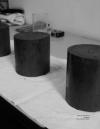Abstract
This paper presents the partial results of a research that intends to blend science of materials, earth construction and theenvironment. The research looks into the soil-cement brick technique, also known as BSC (for its Spanish acronym), for thepossibility of improving its structural performance and durability, by using geopolymerized earth brick mixes, replacing bothpartially and totally the use of Portland cement, in order to diminish CO2 emissions into the atmosphere.In order to prepare thedifferent mixes, a characterization of ready-for-disposal soil was carried out using X-Ray Diffraction (XRD); sodium hydroxideand type-F fly ash were then used. Three types of mix compounds were designed and tested for breakage and compressionstrength in local dedicated construction-material laboratories. Two of these compounds passed, and even surpassed, thetests for Colombian-normative for 28-day-old soil-cement bricks (earth bricks stabilized with Portland cement).The abovegeopolymerized earth bricks will be used in the construction of sustainable welfare housing in Medellín, Colombia. Sustainable construction; geopolymer; fly ash; soil-cement, heritage.Apuntes is registered under a Creative Commons Attribution 4.0 International Public License. Thus, this work may be reproduced, distributed, and publicly shared in digital format, as long as the names of the authors and Pontificia Universidad Javeriana are acknowledged. Others are allowed to quote, adapt, transform, auto-archive, republish, and create based on this material, for any purpose (even commercial ones), provided the authorship is duly acknowledged, a link to the original work is provided, and it is specified if changes have been made. Pontificia Universidad Javeriana does not hold the rights of published works and the authors are solely responsible for the contents of their works; they keep the moral, intellectual, privacy, and publicity rights.
Approving the intervention of the work (review, copy-editing, translation, layout) and the following outreach, are granted through an use license and not through an assignment of rights. This means the journal and Pontificia Universidad Javeriana cannot be held responsible for any ethical malpractice by the authors. As a consequence of the protection granted by the use license, the journal is not required to publish recantations or modify information already published, unless the errata stems from the editorial management process. Publishing contents in this journal does not generate royalties for contributors.


